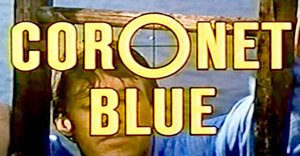Coronet Blue was a TV series broadcast as a summer replacement series in 1967, though it had been shot in 1965. Though the show intrigued audiences and was popular, it was terminated after 11 of its 13 episodes were broadcast as it was felt that it was too intellectual for a mass audience. Converse had moved on to the police series N.Y.P.D. as Jack Warden’s co-star. N.Y.P.D. debuted on September 5, 1967, shortly after Coronet Blue‘s run expired.
The series started out with a man called Michael Alden, played by actor Frank Converse (best known for starrig as the trucker in the 1974-76 TV series Movin’ On) having fallen into New York City’s East River, from which he extricates himself. He is an amnesiac who canot recall the past, except the words “Coronet Blue,” whch he repeats to himself as he climbs up a ladder, out of the river, in the opening credits. Michale Alden is the target of mysterious assassins out to kill him. To find out about his past, he must break the secret of Coronet Blue.
The series was cancelled in the fall of 1967 without revealing the secret of Coronet Blue. Larry Cohen, who created the series, explained the essenital mystery behind the series.
“When the Brodkin Organization took over the series, they wanted to turn it into an anthology… so they played down the amnesia aspect until there was nothing about it at all in the show. It was just Frank Converse wandering from one story to the next with no connective format at all, Cohen is quoted in the biography about the screenwriter, The Radical Allegories of an Independent Filmmaker.
“Anyway, the show ended after seventeen weeks and nobody found out what ‘coronet blue‘ meant,” Cohen said. “The actual secret is that Converse was not really an American at all. He was a Russian who had been trained to appear like an American and was sent to the U.S. as a spy. He belonged to a spy unit called ‘Coronet Blue.’ He decided to defect, so the Russians tried to kill him before he can give away the identities of the other Soviet agents. And nobody can really identify him because he doesn’t exist as an American. Coronet Blue was actually an outgrowth of ‘The Traitor’ episode of The Defenders.”
The Defenders was a popular and acclaimed episodic TV series about a law firm run by a father and son that ran for four seasons on CBS from 1961 through 1965. It won the Emmy Award as Best Dramatic Series for three straight years (1962, ’63 & ’64). “The Traitor” was the 22nd of 34 episodes broacast during The Defenders‘ second season, debuting on February 16, 1963. The episode, which was written by Cohen, featured a lawyer played by Fritz Weaver defending an accused traitor. The lawyer must defend the man, whose traitorous conduct disgusts him.
Coronet Blue, thus, is the code name for a cell of Soviet spies. But what does the phrase “Coronet Blue” actually mean?
A “Blue Coronet” would refer to a midget camera produced some 30 years before the TV show was produced. A Coronet was an inexpensive fixed focus camera manufactured by the Coronet Camera Co (Birmingham, England) circa 1935 that sold for $2.50 (approximately $35.00 in 2006 dollars). A blue Coronet camera would feature a mottled blue bakelite (early form of heavy plastic) body and be equipped with a Taylor Hobsen Meniscus F10 lens with single speed of 1/30. The midget Coronet camera used 16mm film with six exposures per roll. Such a camera would be used in espionage work before World War II, and thus indicates a background in espionage for Michael Alden and, more specifically, his handlers, the latter whom would have come of age and launched their own espionage careers before or during the war.
Coronet Blue” could be a slang-type reference to a police car as Dodge Coronets were used as police squad cars and pursuit vehicles in the mid-1950s and the mid- to late-1960s; “blue” is a slang term for police. A civilian Dodge Coronet would simply be a “Coronet,” but a “Coronet Blue” would mean a police car, likely one that is unmarked. A speeder or someone on the outs with the law looking for signs of police (such as being followed by an unmarked car) might make a reference to a “Coronet Blue” when seeing a Dodge of that make, meaning that the car in question was an undercover, unmarked police car. Conversely, “Coronet Blue” would then refer to the series protagonist Michael Alden himself since, as a secret agent, he himself is an undercover kind of “cop” or “blue”.
As well as referencing a brand of midget camera manufactured before World War II, “Coronet Blue” may be a pun perpetrated by the writers. In 1964, Chrysler reintroduced the Dodge Coronet (the car originally had been produced from 1953-57) for the 1965 model year. The writers may have thus intended savvy viewers to link the word “Coronet” with “Dodge,” as the main character, Michael Alden, was dodging potential assassins during the lifetime of the show.
Though broadcast in 1967, the show was produced in 1965, near the time of the re-introduction of the Dodge Coronet. Since the mid-1930s, Chryslers were favored by many police departments as pursuit cars because of their faster acceleration than similar vehicles from Ford and General Motors due to their large, powerful Mopar engines. In 1956, Chrysler introduced its first official police package: the make was the Dodge Coronet.
Beginning in 1963, Chrysler squad cars featured a big-block 413 Mopar engine (413 cubic inches) that produced 360 horse-power and 470 foot-lbs. or torque that were able to run a quarter mile in 15-16 seconds. The Dodge Polara had a top speed of 129 mph. By 1965, Chrysler’s Dodge and Plymouth models were favored police pursuit vehicles, used by nearly every state. Their 383 cubic inch Mopar engine produced 330 horse-power and accelerated from 0 to 60 in 7.7 seconds flat despite their weight. In the very year that “Coronet Blue” was made, Chrysler produced for the 1966 model year a Dodge police car featuring the 440 Wedge which produced 365 hp and 480 foot-pounds of torque with a single carburetor; it remained the top police engine until 1978.
Any police aficionado or car buff would thus have equated Dodge, makers of the Coronet, with police work.
Sources:
TV.Com, “”Coronet Blue”
TV Squad.Com. “Short-Lived Shows: Coronet Blue – VIDEO”
Wes Clark.Com, “The Mystery of “Coronet Blue” Revealed”
Reference:
- Internet Movie Database Entry www.imdb.com/title/tt0061242/





